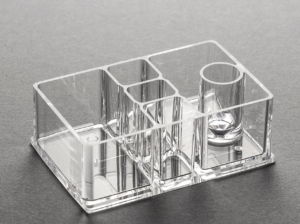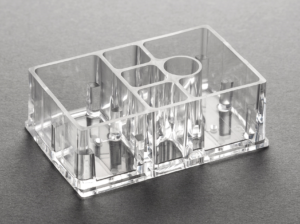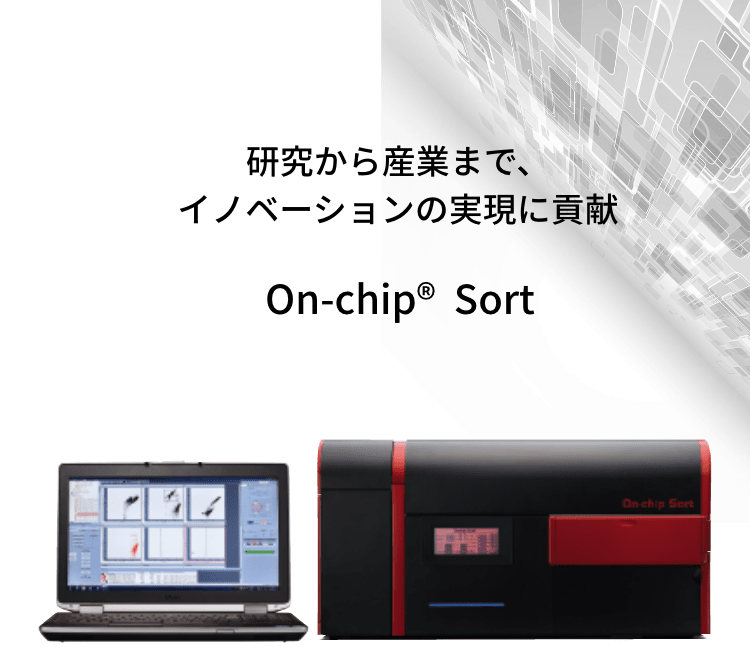Microfluidic chip cell sorter: On-chip® Sort

On-chip® Sort is the world’s first microfluidic chip-based cell sorter. Integrating the processes of sample detection, separation, and collection within a microfluidic chip has realized a small footprint and easy-to-use cell sorter. This system contributes to the analysis and sorting of a wide range of samples including fragile cells, cell clusters, microorganisms and emulsion droplets. Our microfluidic technology allows for sorting of variety of sample types including those that were impossible to sort using conventional cell sorters. On-chip® Sort will expand the range of sample analysis and contribute to many areas of science research and to a variety of industries.
Applications
High throughput screening of microorganisms and cells
Screening of environmental microbes, antibody-producing cells, and mutant strains using droplets.
Sorting of cells damage-free
Isolation of cells and large particles vulnerable to stress.
Sorting of rare cells
Ensuring the enrichment of rare cells— even one cell in 10⁷ cells.
Sorting of cell clusters and large particles
Isolation of cells and large clusters up to 130 μm.
Sorting of water-in-oil emulsion droplets
Isolation of water-in-oil emulsion droplets with oil as the sheath fluid due to the ability to use any sheath fluid of your choice.
Features
All-in-one processing of analysis and sorting with a microfluidic chip
On-chip® Sort integrates the entire process from sample analysis to separation on a small microfluidic chip with measurements of 5.5 cm × 4.0 cm.
In contrast to Jet-in-air and cuvette-hybrid sorting methods used on conventional cell sorters, the Flow Shift method of On-chip® Sort does not cause damage to cells due to the use of less than flow speed of 1 m/s and pressure of 0.3 psi. The Flow Shift method sorts a target cell by generating a short liquid pulse by pressurization of air to deflect the target cell into the collection reservoir (patent Nos. US10101261, US10222317, US10724938, and US10648899).

Easy and maintenance-free operation
On-chip® Sort’s workflow requires no waiting time and operation is easy and user-friendly.
Maintenance and cleaning are not required on On-chip® Sort as all the solutions on the microfluidic chip are driven by air and hence no liquid will be in contact with any parts of the instrument.


Compact and contamination-free
On-chip® Sort is compact enough to be installed in a biosafety cabinet.
Sample analysis and sorting are contamination-free due to the use of disposable microfluidic chips.
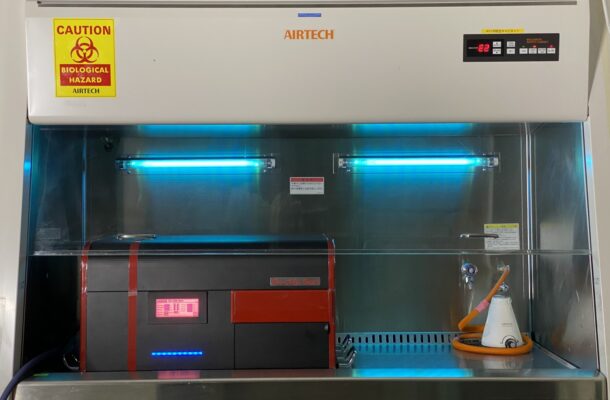
Wide selection of samples and sheath fluids and sample solutions
As cells are sorted using regulation of liquid flow inside the microchannels, hence a wide range of liquids can be used as sample and sheath fluids, including culture medium and oil.
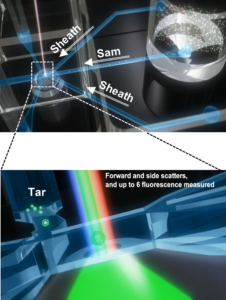
Optical technology
The sample flowing through the microfluidic channel is irradiated with up to three separate lasers from the top of the microfluidic chip.
Forward-scattered light (FSC), an indicator of the size of the sample particles, and side-scattered light (SSC), an indicator of the complexity of the internal structure, are acquired. The SSC acquisition with a microfluidic chip is our proprietary technology (patent No. 5382852).
Fluorescence is detected with high sensitivity in a wide range by up to six separate detectors (FL).
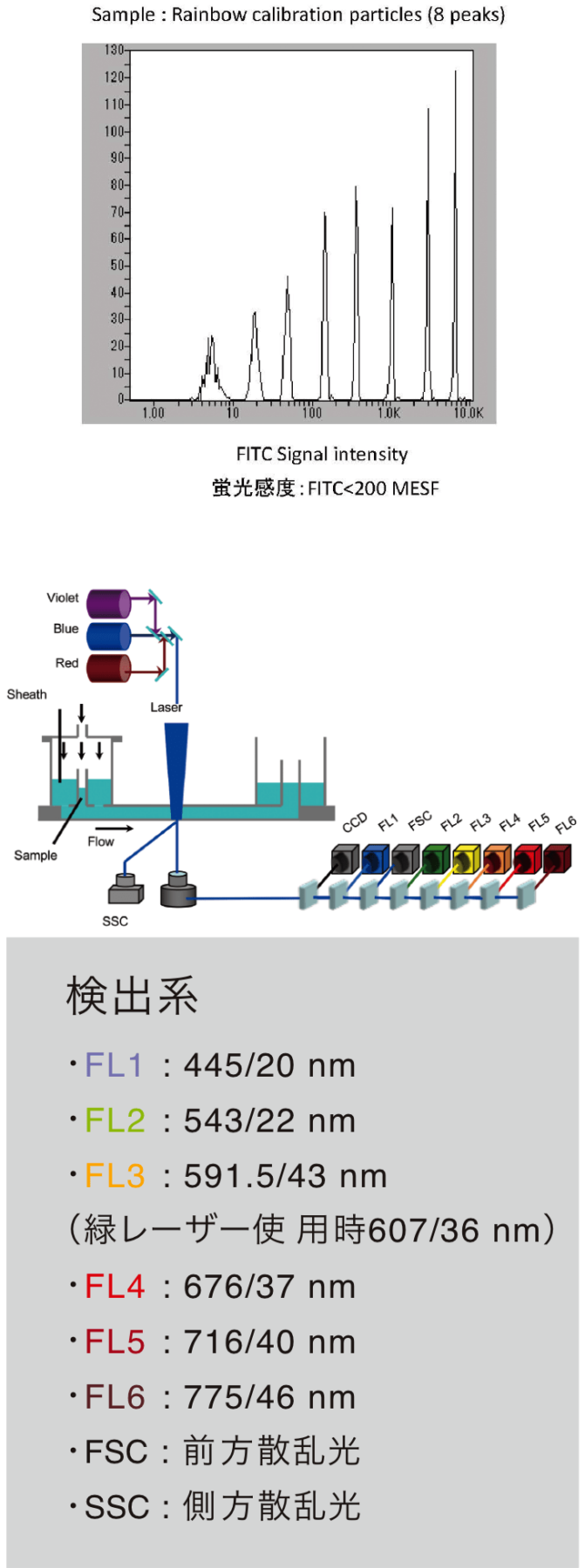

On-chip® Sort is capable of sorting water-in-oil (W/O) emulsion droplets and gel microdrops (GMDs). W/O droplets are liquid droplets dispersed in oil and are stabilized by surfactant. GMDs are droplets solidified using gels. Both W/O droplets and GMDs can be produced by our droplet generator, On-chip Droplet Generator, for single cell analysis and microorganism/cell culturing.

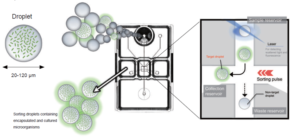
Droplet sorting examples
Fluorescence intensity-based sorting following cultivation of a single bacterium enclosed inside droplets allows selective sorting of only the droplets with proliferated cells.
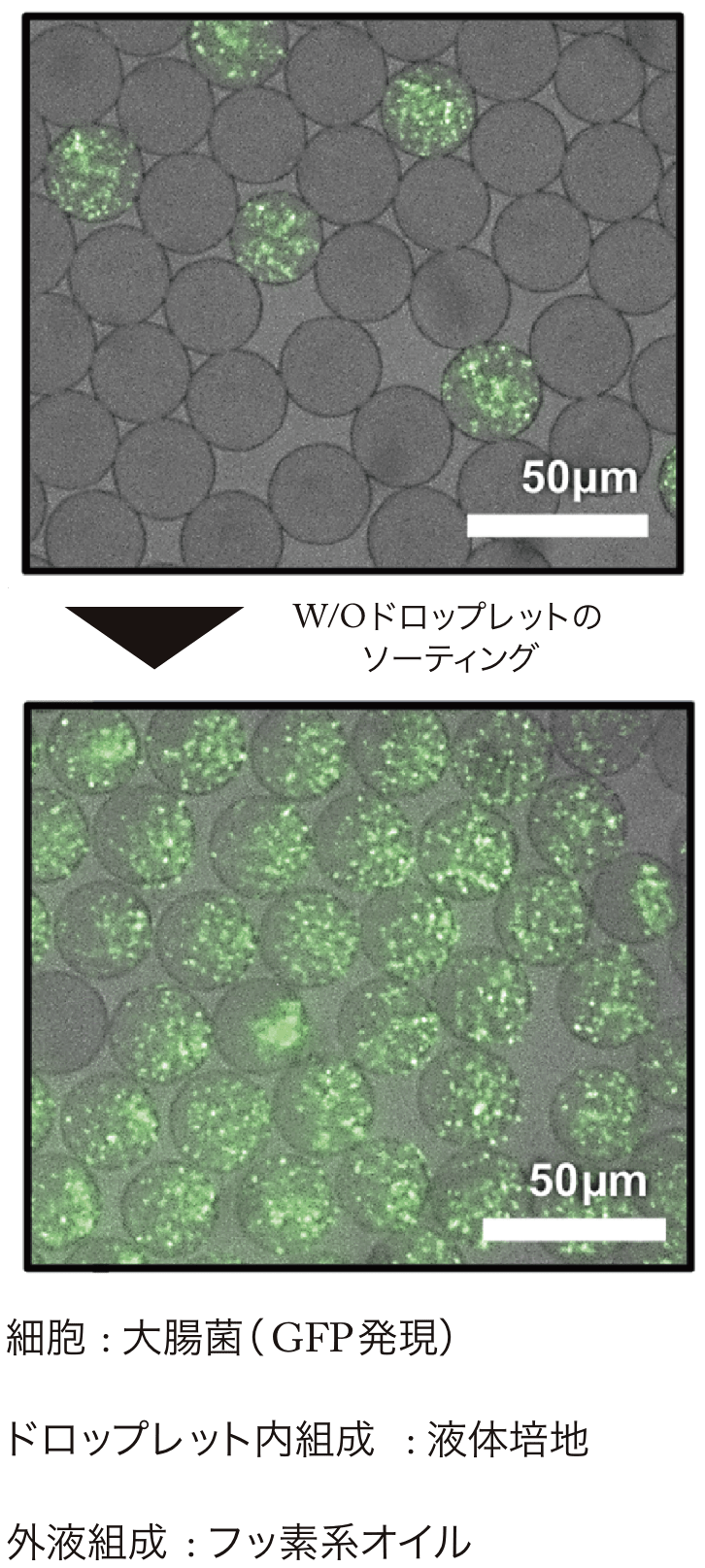
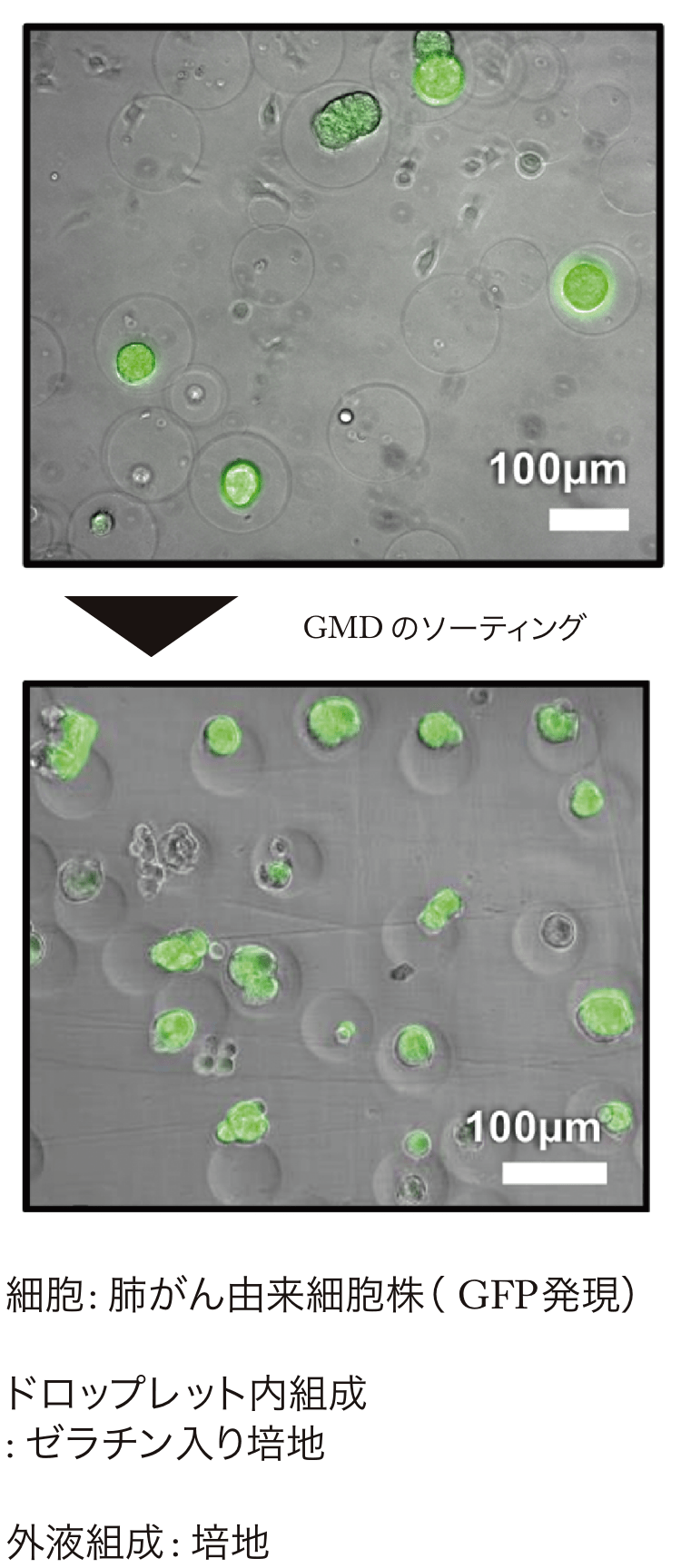

Screening of environmental microorganisms using fluorescent nucleic acid probes
High-throughput analysis and sorting of droplets using On-chip® Sort enables the construction of a screening system for target enzyme-producing environmental microorganisms, microbial dark matter, and artificially mutated strains.
Environmental microorganisms were encapsulated together with fluorescent probes in W/O droplets (one microorganism per droplet) and cultured. The single-cell compartmentalization using many droplets for a variety of microorganisms with differing growth rates enables each microorganism to be cultured for a long period of time without being eliminated, and to be screened using fluorescent probes as indicators.
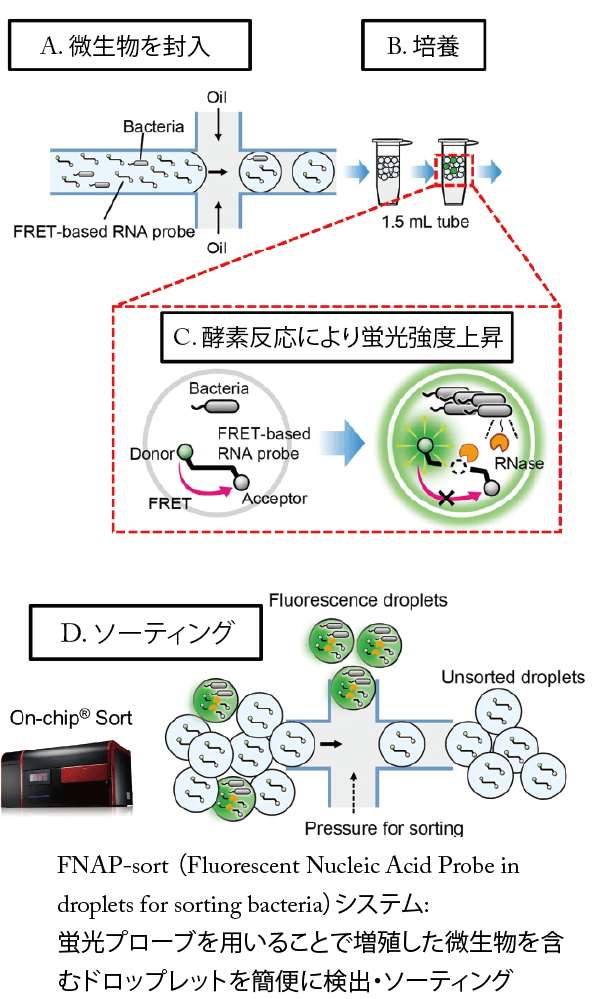
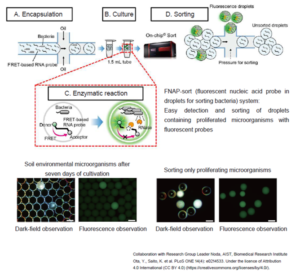
Compared to sorting with conventional cell sorters, sorting using On-chip® Sort has been proven to be less damaging to cells, as it has less effect on cell proliferation, morphological changes, and gene expression. This is because On-chip® Sort employs a unique cell sorting mechanism to eliminate all the damaging steps in cell sorting on conventional sorters.
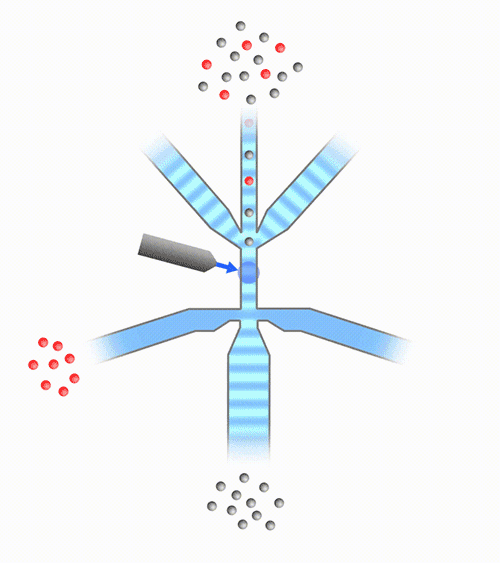
| Conventional sorter | On-chip® Sort | |
|---|---|---|
| Sheath fluid | Specified | Free to choose |
| Pressure | High(5−100 PSI) | Low(1.3PSI) |
| Ultrasonic wave | Applied during droplet preparation | None |
| Electric charge | High voltage (cells are charged) | None |
| Collison | Collision to reservoir | None |
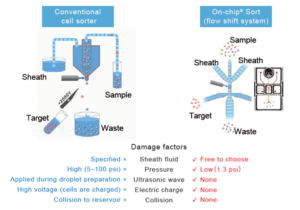
Effects of sorting on cell growth and cell morphology
In comparison to sorting with conventional cell sorters, the cell growth and cell morphology have not been affected after sorting with On-chip® Sort.
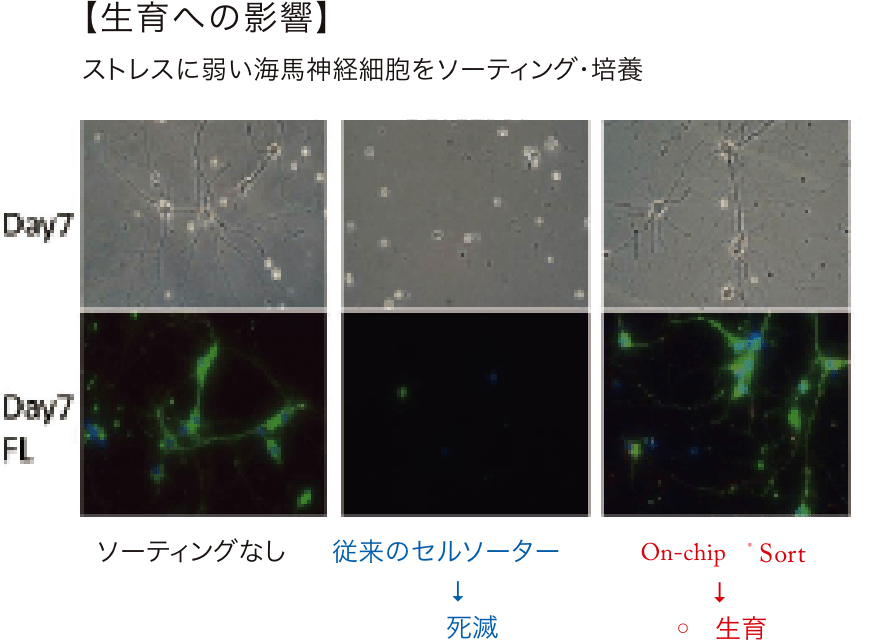
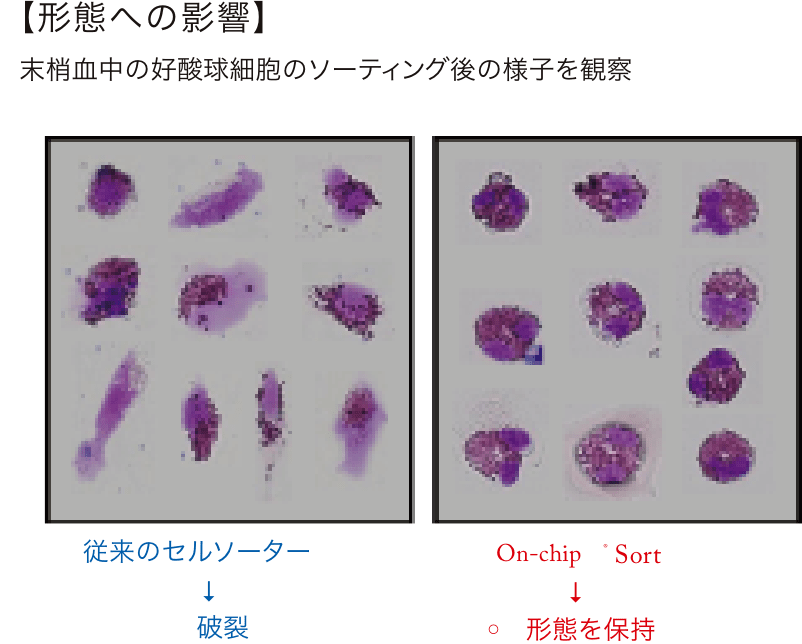
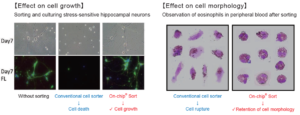
Effects of sorting on gene expression
The changes in gene expression levels were investigated after sorting using On-chip® Sort and a conventional cell sorter. For genes related to cell proliferation and apoptosis, which affect cell growth, it was found that the amount of genetic change was smaller when sorting was performed using On-chip® Sort.
In addition, for all the data analyzed, the number of genes whose expression patterns changed significantly was only about one-fifth of that sorted using a conventional cell sorter.
These results suggest that the genetic change induced by sorting on On-chip® Sort is less than that on conventional sorters.
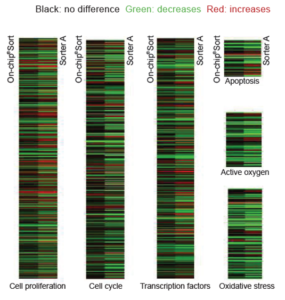
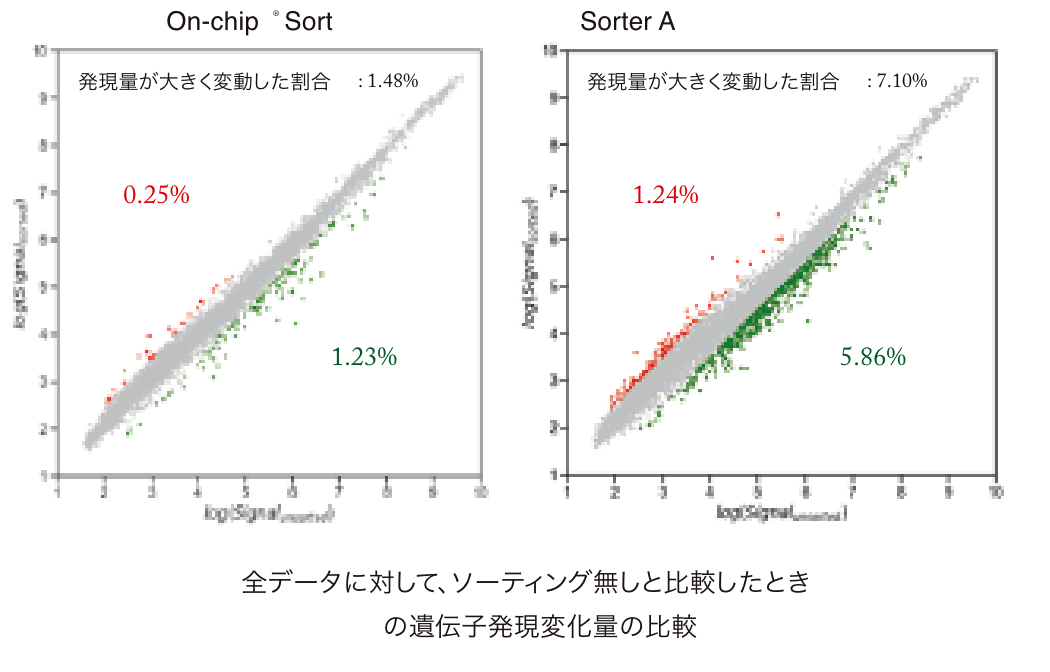

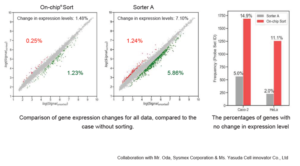
On-chip® Sort enables rapid and accurate recovery of rare cells by repeated sorting of samples. Repeated sorting has always been difficult with conventional cell sorters due to the damage it causes to cells and the inability to analyze small sample volumes, but the use of On-chip® Sort’s damage-free sorting technology and microfluidic chip makes multistep sorting of samples possible.
Multistep sorting technology
Multistep sorting is a novel way to isolate very rare target cells present in a highly concentrated bulk sample. At the first sort, liquid pulses created by air pressure deflect the target cell and its surrounding non-target cells into the collection reservoir. The collected cells are re-sorted further to reduce the number of non-target cells and enrich the rare target cells. Each sort takes about 10 min.
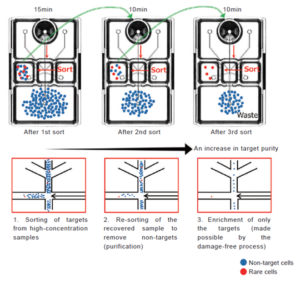
High-purity recovery of circulating tumor cells by multistep sorting
On-chip® Sort allows rapid and high purity recovery of extremely rare cells, such as circulating tumor cells (CTCs). CTCs are cancer cells that have detached from the primary cancerous tissue and are circulating in the bloodstream. The analysis of highly purified CTCs is expected to be used for clinical trials such as cancer diagnosis.
Multistep sorting demonstrated that a few dozen target cells could be recovered with minimal loss from a sample containing 107–108 cells.
A very small number of target CTCs present among cells in lysed blood were specifically stained, and multistep sorting was performed to enrich the CTCs. Microscopic observation after three repeated sorts confirmed that CTCs were recovered with high purity.
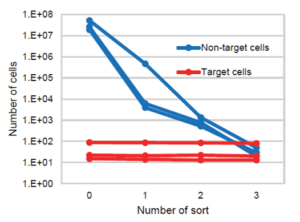
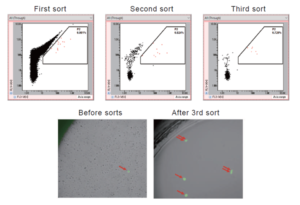
Cell clusters and large particles up to 140 μm in diameter, which conventional cell sorters cannot sort, can be sorted using On-chip® Sort.
On-chip® Sort allows the use of any sheath fluid of your choice, including saline, culture medium, and oil, in order to maintain the samples at their physiological condition and minimize the cell damage during sorting.
Sorting of spheroids (cell cluster)
The use of spheroids (cell clusters) to assess drug sensitivity is important for evaluating drug efficacy in cancer therapy. On-chip® Sort can sort spheroids of a particular size from a spheroid culture or clinical materials for the purpose of preparing a monodisperse spheroid sample.

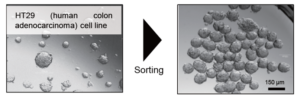
Freedom of sheath fluid of your choice
On-chip® Sort allows choosing any sheath fluid of your choice in order for the samples to be maintained at their physiological condition and minimize the cell damage during sorting.
Termites rely on the protists present in their intestine to provide enzymes to digest the wood materials for food. Using a conventional cell sorter to sort those protists remains a challenge, because some protists are large and a specific solution has to be used as sheath fluid to prevent osmotic pressure-induced cell damages during sorting. On-chip Sort showed to successfully sort out large protozoa.
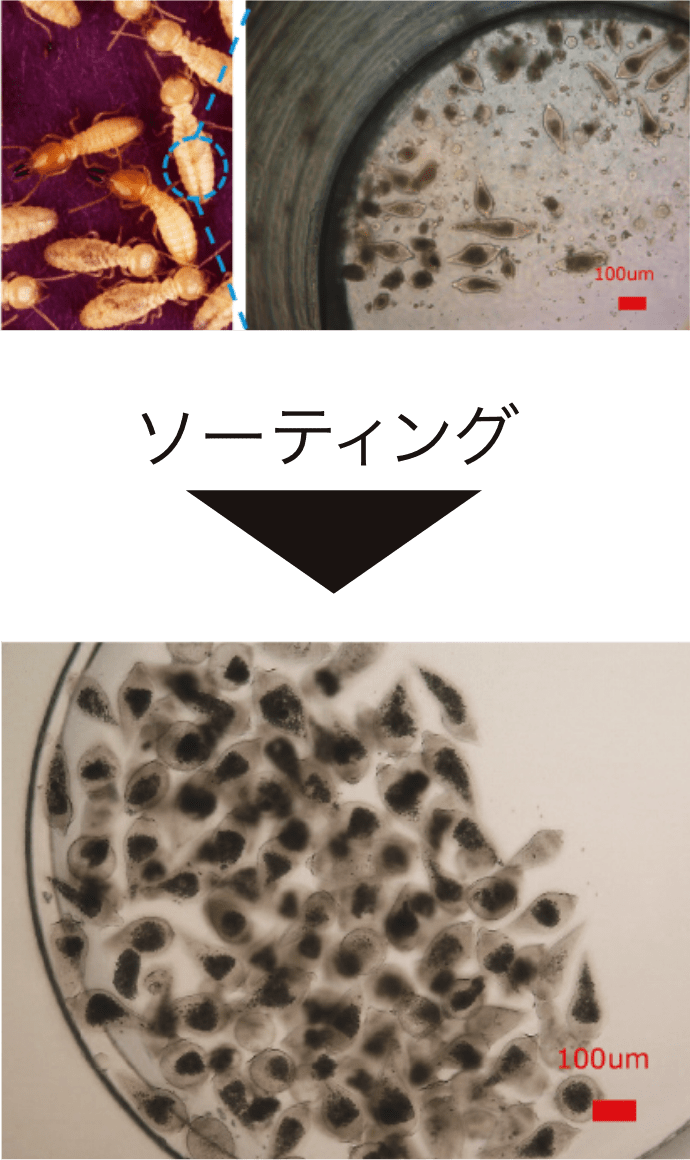
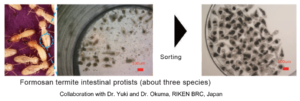
Application 1: Sorting of droplets containing encapsulated cells
Microorganisms
• Escherichia coli
• Mycorrhizal fungi
• Bacillus subtilis
• Actinobacteria
• Aspergillus
• Mold
• Yeast
• Oil-producing algae
•Tetrahymena
Environmental samples
• Soil bacteria
• Microorganisms in seawater and lake water
• Gut bacteria
• Microplankton
HTS screening
• CHO cells
• Hybridoma
• Cell-free translation system
• GPCR reaction system
Genes
• Digital PCR
Non-living materials
• Beads
• PEG
• Gelatin
• Low melting point agarose
• Alginic acid
• Collagen
Application 2: Sorting of cells damage-free
Cellular tissue
• Hepatocytes
• Muscle cells
• Chondrocytes
• Alveolar epithelial cells
• Purkinje cells
• Retinal ganglion cells
• Cardiomyocytes
• Neurons
• Neuronal nucleus
• Microglia
• Cone cells
• Adipocytes
• Gingival epithelium progenitors
• Fibroblasts
• Vascular endothelial cells
• Cancer cells
Stem cells
• Hematopoietic stem cells
• iPS cells
• Cancer stem cells
• Tooth root cells (Muse)
• Mesenchymal cells
Germ cells
• Spermatozoa
• Ovary cells
• Fertilized ova
Cultured cell lines
• Cloning cells
• Genome-edited cells
• HeLa cells
Blood cells
• T cells
• B cells
• NK cells
• Neutrophils
• Platelets
• Macrophages
Other cells
• Other cells
• Rat neurons
• Fish primordial germ cells
• Drosophila cells
• Mouse tissue cells
• Mouse egg cells
• Zebrafish neurons
Application 3: Sorting of rare cells
Cancer cells
• Circulating tumor cells (CTCs)
Stem cells
• Removal of undifferentiated iPS cells
Application 4: Sorting of cell clusters and large particles, and freedom of sheath fluid of your choice
Protists
• Nematodes (L1 stage)
• Euglena
• Termite intestinal protists
• Nematode eggs
Cell masses
• Spheroids
• Organoids
• Clumps of cancer stem cells
• Bone marrow cell clusters
Plant cells
• Pollens
• Stoma cells
• Mesophyll cells
• Protoplasts
| Optical system and detection sensitivity | ||
|---|---|---|
| Laser | Up to 3 lasers from 488 nm, 405 nm, 561 nm, 638 nm; customization available) | |
| Measurement parameters | Forward scatter light (FSC), side-scatter light (SSC), 6 PMT | |
| Size detection sensitivity | FSC < 0.5μm、 SSC < 1.0 μm | |
| Fluorescence sensitivity | < 200 MESF FITC | |
| Data analysis capability | Four decades, 18-bit | |
| Pulse analysis | Height, Area, Width | |
| Detection wavelength | FL1 (445/20 nm), FL2 (543/22 nm), FL3 (591.5/43 nm), FL4 (676/37 nm), FL5 (716/40 nm), FL6 (775/46 nm) | |
| Fluid channel system | ||
| Flow cell | Disposable microfluidic chip | |
| Chip material | COP | |
| Channel size | 80 μm × 80 μm,150 μm × 150 μm | |
| Flow rate | ≥ 500 mm/sec | |
| Sheath buffer | Any liquid can be used as long as COP is not dissolved. Please consult us | |
| Sample fluid volume | 10 – 1000 μL | |
| Sheath fluid volume | 1 ~ 9 mL | |
| Analysis and sorting | ||
| Sorting method | “Flow shift” method in the microfluidic system | |
| Purity | > 95% (depends on concentration) | |
| Yield | > 80% (depends on condition) | |
| Cell damage | No | |
| Cross-contamination free | Yes, because of the disposable chip | |
| Aseptic sorting | Yes | |
| Pressure | 0.3 – 3psi | |
| Maximum detection speed | 4,000 events/sec | |
| Maximum sorting speed | 1000 targets/sec | |
| Start-up | 5 min | |
| Shutdown | 10 sec (no cleaning necessary) | |
| Safety | ||
| Generation of aerosol | No | |
| Size and weight | ||
| Size (W × H × D, mm) | 620 × 330 × 390 | |
| Weight | 45 kg | |
| Operating PC | ||
| PC | Laptop PC | |
| OS | Windows 10、64 bit | |
| Data format | Own format and FCS3.0 | |
| Power supply | ||
| Power requirement | AC100-240V, 50/60Hz | |
| Power consumption | < 240 VA | |
Instrument and consumables information
| Product number | Product name | Specification summary | Lasers | Detectors |
|---|---|---|---|---|
| 362S3001 | On-chip® Sort HS | Laser 3, FS, SS, FL(6 colors) | 488 nm & 638 nm & 405 nm | FL1 FL2 FL3 FL4 FL5 FL6 |
| 362S3001G | On-chip® Sort HSG | Laser 3, FS, SS, FL(6 colors) | 488 nm & 561 nm & 405 nm | FL1 FL2 FL3 FL4 FL5 FL6 |
| 362S3001GR | On-chip® Sort HSGR | Laser 3, FS, SS, FL(6 colors) | 488 nm & 561 nm & 638 nm | FL1 FL2 FL3 FL4 FL5 FL6 |
| 262S3001 | On-chip® Sort MS6 | Laser 2, FS, SS, FL(6 colors) | 488 nm & 405 nm | FL1 FL2 FL3 FL4 FL5 FL6 |
| 252S3001 | On-chip® Sort MS5 | Laser 2, FS, SS, FL(5 colors) | 488 nm & 638 nm | FL2 FL3 FL4 FL5 FL6 |
| 252S3001G | On-chip® Sort MS5G | Laser 2, FS, SS, FL(5 colors) | 488 nm & 561 nm | FL2 FL3 FL4 FL5 FL6 |
| 152S3001 | On-chip® Sort LS5 | Laser 1, FS, SS, FL(5 colors) | 488 nm | FL2 FL3 FL4 FL5 FL6 |
| 132S3001 | On-chip® Sort LS3 | Laser 1, FS, SS, FL(3 colors) | 488 nm | FL2 FL3 FL4 |
Lasers: Up to three types including blue (488 nm) as standard and two selected from violet (405 nm), green (561 nm), or red (638 nm) can be used (additional types are also available).
Detectors: Up to six fluorescence detectors FL1 to FL6 can be installed.
FL1: 445/20 nm, FL2: 543/22 nm, FL3: 591.5/43 nm (607/36 nm when using green laser), FL4: 676/37 nm, FL5: 716/40 nm, FL6: 775/46 nm
Consumables
Microfluidic chip
| Product number | Product name | Materials | Usage | Microchannel size | Packaging unit |
|---|---|---|---|---|---|
| 1002004 | 2D Chip-Z1001 | COP | Sorting of standard samples | 80 x 80 μm | 10 chips/box |
| 1002004S | 2D Chip-Z1001S | COP | Sorting of standard samples in sterilized condition | 80 x 80 μm | 10 chips/box |
| 1002005 | 2D Chip-Z1000-w150 | COP | Sorting of cell clusters and large particles | 150 x 150 μm | 10 chips/box |
| 1002005S | 2D Chip-Z1000-w150S | COP | Sorting of cell customers and large particles in sterilized condition | 150 x 150 μm | 10 chips/box |
